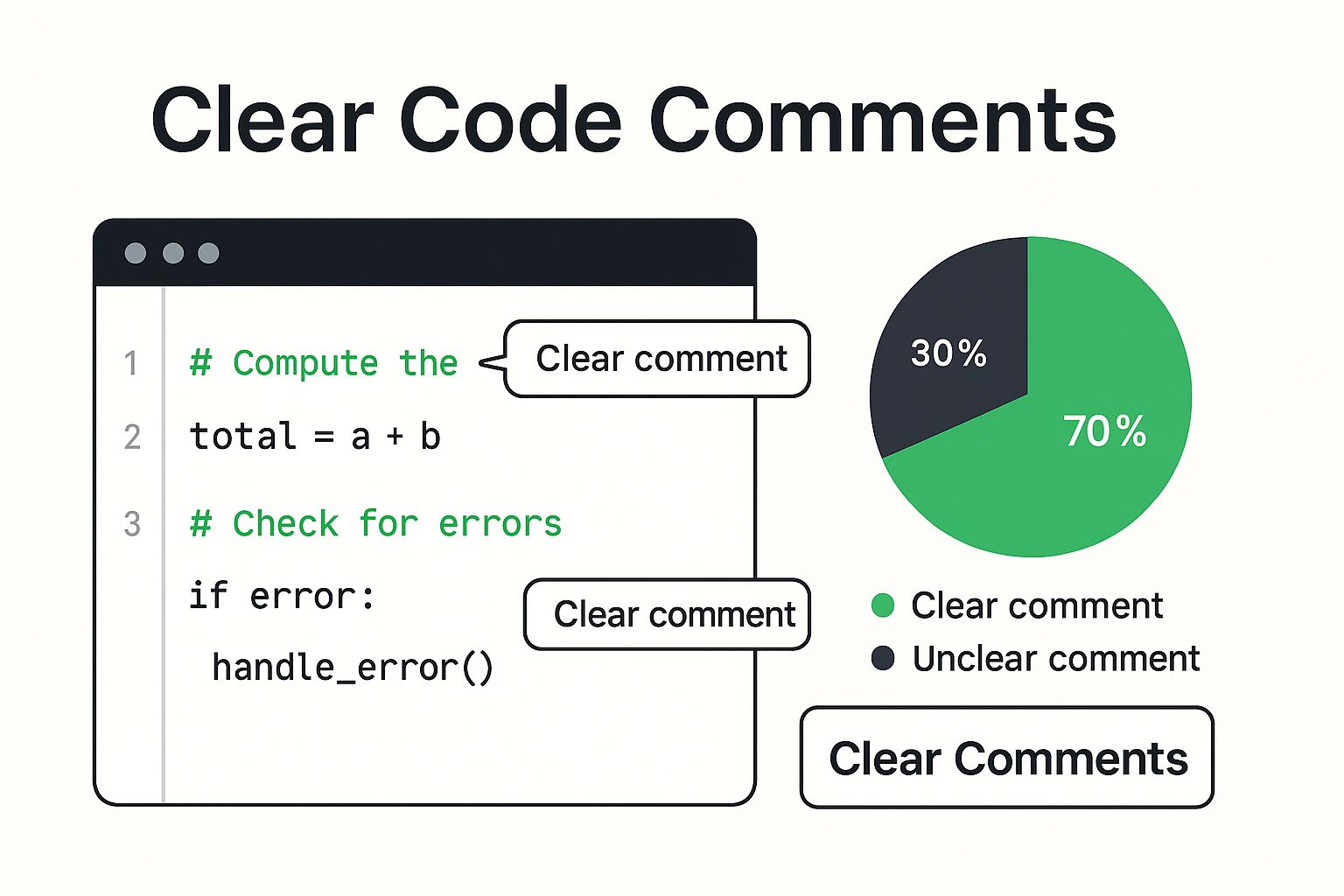Master in code documentation with proven strategies from industry experts. Transform your development workflow with practical tips that drive results.

Effective in-code documentation is essential for any successful software project. It allows teams to understand, maintain, and expand their codebases effectively. This can determine whether a project flourishes or struggles. This section explores the key principles of writing valuable documentation.
In-code documentation, unlike external documentation, resides within the code itself. This includes comments, docstrings, and annotations that explain the what, why, and how of particular code segments. This clarifies complex logic, function parameters, and the behavior of classes and methods. For instance, a well-written docstring can describe a function’s purpose and its arguments’ expected data types.
A common misconception is that more documentation is always better. Overusing documentation can make a codebase harder to read and maintain. Finding the right balance is key. Focus your efforts on documenting complex algorithms, unusual behaviors, or sections needing further clarification for future developers. If the code is clear, let it stand on its own.
Several frameworks can improve your in-code documentation.
Following these guidelines makes your in-code documentation a valuable resource. This strong foundation will prepare you to explore modern tools and technologies that are changing how we document code.

Creating and maintaining good in-code documentation is a big job. But the right tools can significantly simplify the process, allowing developers to concentrate on writing code. Let’s look at some tools reshaping how developers handle in-code documentation.
Artificial intelligence is changing many aspects of software development, including documentation. AI-powered tools can analyze your code and automatically generate documentation. For instance, tools like DocuWriter.ai understand your code’s context and purpose, creating docstrings, comments, and even external documentation with minimal developer input. This automation saves valuable time and ensures consistency across the codebase.
Creating in-code documentation is often a team effort. Platforms that support seamless collaboration between developers are essential. These tools offer features like version control for documentation, real-time editing, and structured review workflows. Integration with popular code repositories like GitHub keeps your documentation synchronized with your code.
The best documentation tools integrate directly into your workflow. Version control for documentation is key, allowing documentation to live alongside your code and evolve with it. Just like code changes, documentation updates can be tracked, reviewed, and reverted. This keeps documentation accurate and current. These strategies also encourage developers to treat documentation with the same rigor as code, which is crucial for long-term documentation success.
The approach to technical documentation has changed dramatically, especially with the rise of in-code documentation. This shift is driven by trends like “docs as code,” which treats documentation like software code, enabling version control and collaborative editing. This trend continues to evolve with the integration of AI tools for more efficient documentation creation and management. AI assistance can lead to significant productivity gains. One study found that AI-assisted programmers completed tasks 126% faster. Learn more about these trends here. These advancements are changing how teams maintain accurate, consistent documentation without impacting development speed.
Every programming language cultivates its own unique documentation style. Understanding these nuances is essential for creating in-code documentation that your team will actually find useful. This involves recognizing the preferred conventions within each language, from Python’s concise docstrings to Java’s robust Javadoc system. Learn more in our article about How to write code documentation: a complete guide for developers.
Effective developers adapt their in-code documentation to match the expectations of each language. For instance, Python prioritizes readability and encourages the use of brief docstrings to describe the function and purpose of classes and functions. Java developers, on the other hand, utilize Javadoc to automatically generate detailed API documentation from comments within the code. This ensures consistency across projects in their respective ecosystems.

This infographic depicts a code file with highlighted comments, underscoring the importance of clear in-code documentation. The prominent placement of “Clear Comments” reinforces their crucial role in code comprehension. Clear, concise comments are vital for maintaining and understanding code over time. This reinforces the message that well-written documentation is key to the development lifecycle.
Maintaining consistency can be more difficult in projects involving multiple programming languages. In these situations, establishing a set of overarching documentation guidelines can be beneficial.
These guidelines could include:
This approach promotes clarity and reduces confusion for developers working across different parts of the codebase.
To further illustrate this point, let’s look at a comparison of documentation standards across various programming languages.
The following table provides a comparison of documentation conventions across popular programming languages.
Programming Language Documentation Standards Comparison
A comprehensive comparison of documentation conventions across popular programming languages including syntax, tools, and best practices.
This table highlights the different approaches to documentation across various languages, emphasizing the need for adaptability and standardized guidelines in multi-language projects. By understanding these differences, teams can create more effective and consistent documentation.
A common mistake is treating documentation as an afterthought. Effective in-code documentation should be an integral part of development from the start. Another pitfall is failing to update documentation alongside code changes. Outdated documentation can be misleading and harmful to a project. Developers should prioritize keeping their documentation current and relevant. Addressing these issues proactively allows teams to fully realize the benefits of good in-code documentation.
Keeping in-code documentation accurate as a codebase grows is a constant challenge. Manually updating it is time-consuming and error-prone. Thankfully, smart automation is changing how teams handle this.
AI is transforming many fields, including documentation. AI-powered tools can interpret code and suggest relevant documentation updates. Imagine an AI that automatically creates docstrings for new functions. This saves time and improves consistency across projects. Some tools, for example, automatically generate documentation for APIs based on the underlying code and annotations. This keeps the documentation synced as the API evolves.
Automated validation tools are also key for catching documentation drift. These tools highlight differences between the code and its documentation. They find problems like outdated descriptions, missing parameters, or formatting inconsistencies. This lets developers fix issues before they impact the team. This proactive approach significantly reduces the risk of inaccurate or misleading documentation.
Teams using automated documentation workflows see substantial advantages. These tools reduce developer workload and improve overall documentation quality. By automating tedious updates, developers can focus on writing better code and creating insightful, high-level documentation. For example, tools can automatically link related code sections within the documentation, simplifying navigation of complex codebases.
The growing use of automation for document-heavy processes is reflected in the Intelligent Document Processing (IDP) market. In 2022, the global IDP market was worth about ****17.8 billion by 2032, with a CAGR of 28.9%. Learn more about the IDP market. This highlights the growing importance of automation in documentation. It makes in-code documentation an active, integrated part of development, not just an afterthought. Automating tedious tasks ensures documentation stays relevant and useful throughout a project’s lifecycle.
Modern documentation practices are evolving, and AI is leading the charge. These new technologies are built with developer workflows and team collaboration in mind. Let’s explore how AI is transforming in-code documentation from a tedious task into a seamless part of development.
Natural Language Processing (NLP) is a game-changer for content organization. NLP empowers systems to understand the meaning and context within your documentation. This allows for automatic categorization and tagging, making it significantly easier to find the information you need. Imagine searching for a specific function and instantly finding all relevant explanations and examples, no matter where they reside in your codebase. This intelligent organization boosts efficiency and reduces time spent searching.
AI is driving some impressive features in documentation systems.
These features combine to create a more intuitive and efficient documentation process.
Documentation is frequently a collaborative process, and AI is improving this as well. Real-time co-editing features, similar to Google Docs, allow multiple developers to work on the same document concurrently. AI can also manage approval workflows, ensuring that all changes are reviewed and approved before publishing. This streamlines the review process and maintains high quality. These collaborative features change how teams handle documentation, making it a shared responsibility rather than an isolated task.
Document management is increasingly shaped by AI-driven automation. These systems automate tasks like sorting, tagging, and filing, leveraging NLP to understand the content. This results in more accurate document classification, fewer errors, and faster workflows. Collaboration tools are also becoming vital, enabling real-time co-editing and greater team productivity. Learn more about current document management trends here.
Integrating these advanced capabilities doesn’t require a complete system overhaul. Start by identifying your team’s biggest documentation challenges. Are developers struggling to locate information? Is maintaining up-to-date documentation an ongoing struggle? After pinpointing the key issues, you can start exploring AI-powered solutions tailored to those specific needs. Even small adjustments can significantly improve your team’s documentation workflow. Platforms like DocuWriter.ai offer features designed to solve these common documentation problems. This makes integrating AI into your documentation process a practical and achievable goal.
Good in-code documentation involves more than simply adding comments. It requires measurable standards and a commitment to continuous improvement. This means shifting the focus from simply checking for the presence of documentation to evaluating its actual impact and effectiveness within the development process. This section offers practical methods for assessing documentation and ensuring it contributes real value to your projects.
Evaluating the effectiveness of your in-code documentation requires tracking relevant metrics. These metrics should reflect how the documentation affects developer productivity and the overall maintainability of the code. Some important categories to consider include:
You might be interested in this resource: How to master code documentation best practices.
Actively seeking feedback from your development team is crucial for ongoing documentation improvement. Regularly solicit input to understand what aspects of the documentation are working well and which areas need improvement. This could involve surveys, feedback during code reviews, or dedicated feedback sessions. Proactively identifying gaps in the documentation helps prevent frustration and potential delays later in the project lifecycle.
Understanding how developers interact with the documentation can provide valuable insights. Tools that track documentation usage can show which sections are frequently accessed, which are rarely used, and which are overlooked entirely. This data can help prioritize updates and ensure the documentation effectively meets the team’s needs. For instance, low usage of certain sections might indicate a need for improved discoverability or suggest that those sections cover information already well-understood by the team.
While the benefits of good documentation might seem intangible, they directly affect a project’s bottom line. Well-maintained in-code documentation accelerates onboarding for new developers, reduces time spent troubleshooting code issues, and enhances code maintainability. This translates directly to cost savings and increased efficiency for the entire development process.
A comprehensive framework for assessment is key to maintaining high-quality documentation over time. The following table details such a framework.
Documentation Quality Metrics And Assessment Framework
This table provides key metrics and evaluation criteria for assessing the effectiveness and quality of in-code documentation.
This table outlines important metrics, measurement methods, target benchmarks, helpful tools, and the recommended frequency for each assessment. By tracking these metrics and implementing regular review processes, your in-code documentation can remain a valuable asset for the development team.
Ready to transform your team’s approach to in-code documentation? This section offers a practical, step-by-step guide for teams of all sizes, from individual developers to large enterprises. We’ll cover proven change management strategies, establishing effective documentation standards, and building a culture of continuous improvement.
Introducing new processes can be a challenge. Team members may resist change, viewing documentation as an added burden. To address this, highlight the long-term advantages of well-maintained in-code documentation. Focus on how it reduces debugging time and simplifies the onboarding process for new developers. A small pilot project can demonstrate the value of improved documentation, building confidence and gathering valuable feedback before a full implementation.
Clear, concise documentation standards are key to consistency. These standards should define what requires documentation, the preferred style, and the expected level of detail. Encourage team participation in creating these standards to foster a sense of ownership. For example, deciding together whether to prioritize detailed comments or concise docstrings ensures the approach aligns with the team’s existing workflow and preferences. This collaborative approach makes the standards more practical and tailored to the team’s specific needs.
Effective training is crucial for successful implementation. Consider workshops or online resources to help team members understand the new standards and utilize documentation tools efficiently. A practical workshop might cover writing effective docstrings, using documentation generators like Sphinx, and integrating documentation into code review processes. Incorporate documentation into daily workflows by including it in code reviews and using automated documentation tools. These tools can automatically generate documentation templates, check for completeness, and identify inconsistencies, seamlessly integrating documentation into the development process.
Documentation is an ongoing effort, not a one-time task. Implement a system for continuous improvement by regularly reviewing documentation standards and soliciting feedback from the team. Update guidelines as needed. Periodic reviews could involve assessing the effectiveness of existing documentation, identifying areas for improvement, and updating standards based on best practices and evolving project needs. This iterative process ensures the documentation remains relevant and valuable over time. By fostering this culture of continuous improvement, you’ll ensure your documentation becomes a valuable asset for your team.